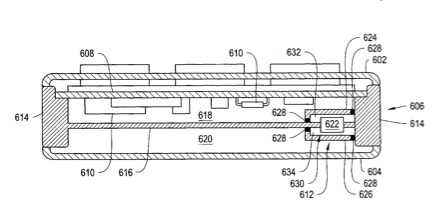Among several Apple patents granted today by the U.S Patent & Trademark Office one of the most interesting is for an integrated speaker assembly for a personal media device. It involves an external multi-speaker system. Though the patent was filed in 2007, Apple has released no such system — at least not yet.
Systems and methods are provided for media devices including a housing, a frame disposed adjacent to the housing, and an acoustic source that is integrated with the frame for emitting sound from the media device. The inventors are Richard Hung Minh Dinh, Tang Yew Tan and Derek Boyd Barrentine.
Here’s Apple’s background and summary of the invention: “This invention relates to personal media devices and, more particularly, to integrated speaker assemblies for personal media devices.
“The proliferation of compact portable personal media devices (e.g., portable MP3 players, portable video players, and media capable cellular telephones) has created a need for delivery of audio (e.g., voice and music) via more durable, reliable, and robust audio sources to users while respecting the need to minimize the overall form factor of personal media devices.
“One problem with existing media devices such as cellular telephones is that the media device’s acoustic source, e.g., a speaker assembly, is susceptible to external forces that can damage subassembly components such as a diaphragm, electric components, or the housing. For example, a hand-held media device may be dropped by a user. An impact, even from a relatively short distance, could result in structural damage to a speaker assembly mounted on an internal printed circuit board (PCB) or mounted to the housing of the media device.
“Additionally, a gasket that provides a seal between the speaker assembly and device housing could buckle or become deformed due to the impact, resulting in reduced acoustic coupling from the acoustic source to the external aperture of the device. Accordingly, there is a need for mounting an acoustic source, such as a speaker assembly, in such a way as to reduce the susceptibility of the source to physical stress resulting from, for example, a physical impact on the device or ‘drop shock.’.”
“Another problem with existing media devices is that the structural rigidity of the acoustic source or its surrounding components or materials may not be sufficient to adequately mitigate the effects of vibrations. For example, vibrations induced from another acoustic source, a user, an alarm, or another vibration source could adversely affect, introduce interference, or reduce the acoustic coupling from an acoustic source to the external aperture of the media device. Accordingly, there is a need for enhanced structural rigidity of the acoustic source or its surrounding materials to enable the acoustic source to more efficiently couple audio to the external housing aperture of a media device while mitigating the effects of vibration or other interference.
“The invention, in various embodiments, addresses deficiencies in the prior art by providing systems, methods and devices that enhance the ability of the acoustic source to withstand physical stresses and enhance sound quality while respecting the need for a compact and portable form factor for such devices.
“In various aspects, the invention employs an acoustic source, e.g., a speaker assembly, in a media device. The acoustic source is integrated with at least a portion of the frame of the media device. Because a frame provides structural support for the media device, the frame generally has greater structural strength than, for example, a housing or internal circuit board of the media device.
“By integrating the acoustic source with a frame having greater structural strength and integrity, the ability of the acoustic source to withstand physical stresses or vibrations is enhanced. The term ‘integrated with’ may include integrally formed with, unitarily formed with, attached to, detachably connected to, mounted on, or any like permanent, semi-permanent, or temporary configuration whereby the acoustic assembly, or a portion thereof, is in physical communication or contact with the frame of the media device.
“In one aspect, a media device includes a housing, a frame disposed adjacent to the housing, and an acoustic source that is integrated with the frame for emitting sound from the media device. The frame may be disposed substantially within the housing. The frame may include a sidewall or plurality of sidewalls. At least one sidewall may include an aperture in acoustic communication with the acoustic source.
“The frame may include a backplane. A portion of the acoustic source may be positioned substantially on a top surface of the backplane. A portion of the acoustic source may be enclosed within an upper casing where the upper casing is attached to the frame. Also, a portion of the acoustic source may be positioned substantially on a bottom surface of the backplane. A portion of the acoustic source may be enclosed within a lower casing where the lower casing is attached to the frame. The frame may be connected to the housing at least one gasket.
“Another aspect of the invention includes a method for manufacturing a media device. The method includes providing a housing, attaching a frame to the housing, and integrating an acoustic source with the frame. The integration may include inserting an acoustic source within a recess of the frame. In one feature, an upper casing is mounted to the frame proximate to the acoustic. In another feature, a lower casing is mounted to the frame proximate to the acoustic source.”


